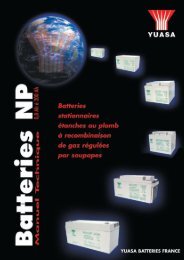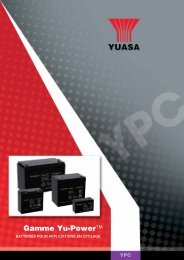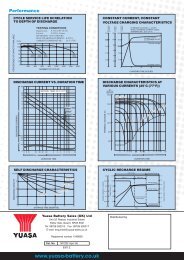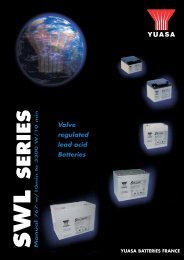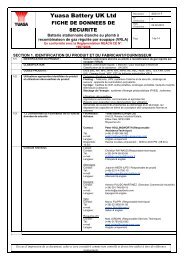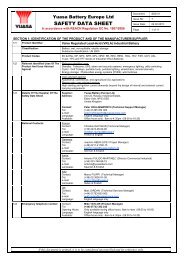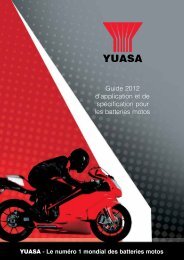YUASA - The world's leading battery manufacturer
YUASA - The world's leading battery manufacturer
YUASA - The world's leading battery manufacturer
Create successful ePaper yourself
Turn your PDF publications into a flip-book with our unique Google optimized e-Paper software.
All You Need To Know About Batteries<br />
Date Coding of batteries for stock rotation purposes<br />
B Maintenance of Stock handling and<br />
recharging of batteries<br />
Information<br />
A - Storage<br />
1 Always rotate your stock. Practice FIFO (First In, First Out).<br />
Batteries slowly lose their charge, and good stock-rotation<br />
stops batteries going flat in storage and makes sure that<br />
the customer buys a good <strong>battery</strong>.<br />
On the back of the <strong>battery</strong>. <strong>The</strong>re is a label showing the<br />
expected period before the <strong>battery</strong> will require recharging.<br />
This makes it easy to identify the oldest and newest<br />
batteries in stock. Please use the recharge date to ensure<br />
that the oldest batteries leave your stock first. Recharge<br />
date is only an indication of recharge period as self<br />
discharge is subject to storage conditions.<br />
2 Store batteries in a cool, dry, well-ventilated area.<br />
3 Protect batteries from excessive heat. (Heat causes<br />
batteries to lose charge more quickly, and excessive heat<br />
can damage batteries).<br />
4 Store batteries in an upright position. (To stop them falling<br />
over or leaking).<br />
5 Do not stack batteries on top of other batteries. (To avoid<br />
scratching, and tearing labels. To avoid damaging terminals<br />
that stand proud of the lid).<br />
6 Store shrink-wrapped batteries up to 3 high. (Any higher<br />
and there is a risk of them falling over and injuring people).<br />
7 Do not remove any seals from dry-charged batteries until<br />
you are ready to commission the <strong>battery</strong> by filling it with<br />
acid. (<strong>The</strong> seal preserves the charge in the <strong>battery</strong>. If it is<br />
broken, air will enter and cause the <strong>battery</strong> to lose charge).<br />
8 Store batteries on racks or on pallets, not on the floor.<br />
(Small stones or sharp points on a concrete floor can<br />
damage the base of the <strong>battery</strong> and cause leakage).<br />
9 Make sure handles are left in the flat (down) position.<br />
Upright handles are more likely to be damaged.<br />
Before handling, charging or installing<br />
batteries, please understand and comply<br />
with the precautions given in ‘Health and<br />
Safety Information’ in this Catalogue.<br />
WET Charged Batteries<br />
1. Batteries should be installed ideally within 15 months after<br />
manufacture. <strong>The</strong> voltage should be (worse case higher<br />
than 12.25V) ideally higher than 12.4V at the time of<br />
installation.<br />
2. Batteries require recharging when the voltage has dropped<br />
below 12.4V due to extended warehouse storage. All safety<br />
precautions should be undertaken prior to recharging<br />
batteries.<br />
See charging instruction section in catalogue for further<br />
details.<br />
If a <strong>battery</strong> has been recharged, the recharge date on the<br />
back label should be updated by 6 months after second<br />
recharge date by physically notching the label. (Note a<br />
maximum of two recharges are allowed prior to sale, and<br />
product should not be sold a maximum of 9 months after<br />
the expiry of first recommended recharge date).<br />
2.1 A voltage check should be carried out as a matter of<br />
course, both to identify older stock and highlight batteries<br />
requiring recharge.<br />
2.2 Use a digital voltmeter/multimeter with a minimum of 2<br />
figure resolution (eg 12.76V).<br />
2.3 Scrap any batteries below 11.0V (these batteries will have<br />
developed sulphation that cannot be completed reversed<br />
by charging and so will not give the expected performance<br />
and life to the customer.<br />
2.4 Note Digital Conductance testers (such as Midtronics<br />
and/or Bosch BAT121) are:-<br />
NOT designed for the testing of new batteries.<br />
Digital <strong>battery</strong> testers are not designed to check the<br />
fully developed cold cranking performance of a<br />
new <strong>battery</strong>.<br />
<strong>The</strong>y are designed purely for the testing and<br />
evaluation of faulty or used batteries.<br />
Any CCA/state of health reading from the test on a<br />
new <strong>battery</strong> CANNOT be a reliable guide as to<br />
specification of the <strong>battery</strong>.<br />
See comments on Digital Conductance testers.<br />
DRY Charged Batteries: Maintenance of Stock<br />
Sales of dry charged batteries within our range is very limited,<br />
usually for specialist markets and hence not listed in this<br />
catalogue.<br />
1. If you keep the batteries cool and dry, and do not remove<br />
the seal, dry-charged batteries do not need any other<br />
attention.<br />
2. <strong>The</strong> maximum storage time of dry-charged batteries before<br />
they are commissioned by filling with acid is 24 months.<br />
3. If the seal is damaged, the batteries should be wetted up<br />
immediately and the product then treated as WET<br />
CHARGED batteries.<br />
188






